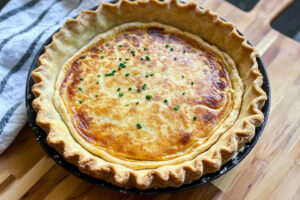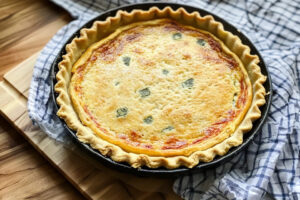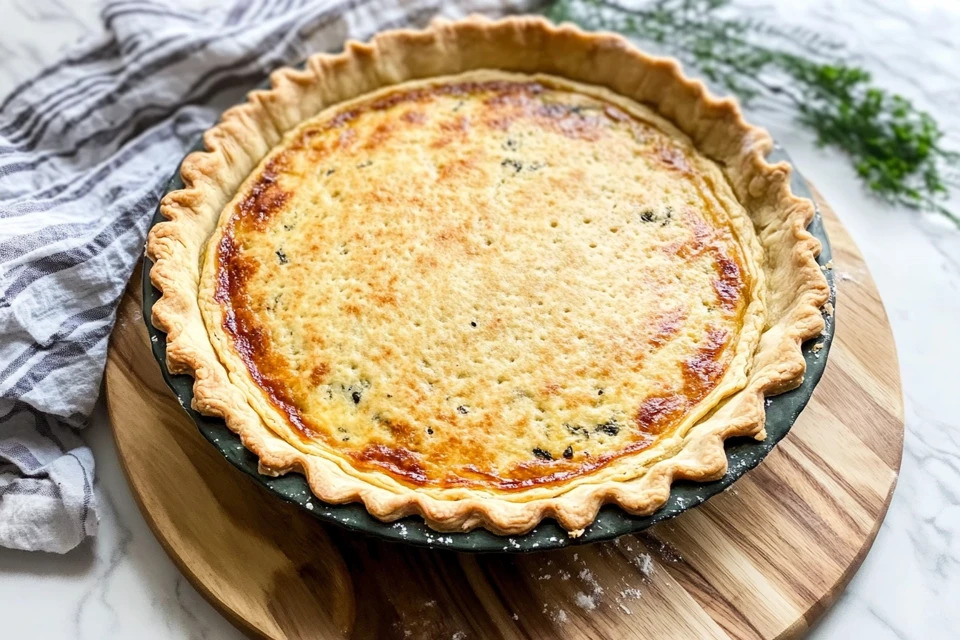The perfect quiche dough recipe is the foundation of a delicious quiche, offering a flaky, buttery crust that elevates this classic dish. Whether you’re a seasoned baker or just starting, mastering this essential skill will ensure your quiche stands out with every bite. This guide will walk you through everything you need to know to achieve that ideal crust.
History and Origins of Quiche
Quiche has its roots in European culinary traditions, with its earliest known iteration tracing back to medieval Germany. The word “quiche” is derived from the German word kuchen, meaning cake. Over time, the dish became a hallmark of French cuisine, particularly in the Lorraine region. The traditional quiche Lorraine featured a simple filling of eggs, cream, and bacon, but as the dish evolved, chefs began experimenting with a variety of fillings, making quiche a versatile staple in global kitchens.
Why Mastering Quiche Dough Matters
The quality of the dough can make or break a quiche. A poorly made crust may turn soggy or overly hard, undermining the flavors and textures of the dish. Mastering quiche dough is about achieving a delicate harmony: a flaky crust that complements the filling without overpowering it. When done right, a perfectly baked quiche dough elevates the dish from good to unforgettable.
Essential Ingredients for Quiche Dough Recipe
Flour Types and Their Role in Texture
The choice of flour plays a pivotal role in determining the texture of quiche dough recipe. All-purpose flour is the most common choice, offering a balance of protein and starch that yields a tender yet durable crust. For a lighter, crumblier texture, pastry flour is an excellent alternative due to its lower protein content. Avoid bread flour, as its high protein level can make the dough too chewy.
The Importance of Cold Butter
Butter is the star ingredient in quiche dough recipe, responsible for its flakiness and rich flavor. Using cold butter is crucial because it prevents it from melting during the mixing process, ensuring small, solid bits remain in the dough. When baked, these butter pockets create steam, which lifts the layers of the dough, resulting in a flaky, tender crust.
Water and Its Role in Binding the Dough
Water acts as the binder that brings the dough together. It’s essential to use ice-cold water to maintain the butter’s chilled state. Adding water gradually allows you to achieve the desired consistency without over-hydrating the dough, which can lead to a tough crust. The goal is a dough that holds together when pressed without being sticky or wet.
The Science Behind Quiche Dough Recipe
Understanding Gluten Formation
Gluten, a network of proteins formed when flour is mixed with water, is the structural backbone of quiche dough recipe. The amount of gluten developed directly impacts the dough’s texture. Too much gluten can make the dough tough and chewy, while too little can result in a crumbly crust that falls apart. Striking the right balance is essential: minimal mixing after adding water helps control gluten development, ensuring a tender, flaky crust.
Why Chilled Ingredients Are Crucial
Chilled ingredients are critical for achieving the right texture in quiche dough recipe. Cold butter maintains its solid form during mixing, creating the layers that produce flakiness when baked. Similarly, cold water slows down gluten formation, giving you better control over the dough’s consistency. Working with chilled ingredients also prevents the dough from becoming greasy, which can happen if the butter begins to melt prematurely.
The Impact of Butter-to-Flour Ratios
The ratio of butter to flour is a defining factor in quiche dough. A higher butter content results in a richer, flakier crust, while a lower butter ratio can produce a sturdier, less tender dough. Most recipes use a 2:1 flour-to-butter ratio by weight, striking a balance between flavor, texture, and ease of handling. However, slight adjustments can be made to suit personal preferences, such as increasing the butter for extra richness.
Tools and Equipment Needed
Must-Have Tools for Perfect Quiche Dough Recipe
- Mixing Bowl – A sturdy mixing bowl is essential for combining ingredients efficiently.
- Pastry Cutter or Fork – These tools help cut the butter into the flour without overworking the dough.
- Rolling Pin – For rolling the dough evenly to the desired thickness.
- Pie Pan or Tart Tin – The base where your quiche will come to life. Choose a pan with a removable bottom for easier serving.
- Measuring Cups and Spoons – Precise measurements are key to consistent results.
Optional Tools for Convenience
- Food Processor – Speeds up the dough-making process by quickly cutting butter into flour.
- Bench Scraper – A handy tool for transferring and shaping dough on your work surface.
- Silicone Baking Mat – Provides a non-stick surface for rolling out dough without the need for excess flour.
- Pastry Brush – For brushing egg wash or glaze onto the crust for a golden finish.
Best Kitchen Setups for Baking Success
- Clean, Flat Work Surface: A spacious, flat area is ideal for rolling out dough without interference.
- Cool Environment: A cooler kitchen helps maintain the dough’s temperature, especially during warmer months.
- Preheated Oven: Consistent oven temperatures ensure the dough bakes evenly and achieves the desired flakiness.
- Storage Space for Chilling Dough: Have room in your refrigerator or freezer to chill the dough during key stages of preparation.

Step-by-Step Quiche Dough Recipe
Preparing the Ingredients
- Measure Accurately: Use a kitchen scale for precise measurements of flour and butter. A typical recipe includes:
- 2 ½ cups (300g) all-purpose flour
- 1 cup (225g) cold unsalted butter, diced
- 6-8 tablespoons (90-120ml) ice-cold water
- 1 teaspoon salt
- Chill Everything: Place the butter, flour, and even your mixing bowl in the refrigerator for about 30 minutes before starting. Keep ice water ready in a small bowl.
Mixing and Combining Techniques
- Combine Dry Ingredients: In a mixing bowl, whisk together the flour and salt.
- Cut in the Butter: Use a pastry cutter or your fingers to rub the butter into the flour until the mixture resembles coarse crumbs. Some pieces of butter should remain pea-sized to ensure flakiness.
- Add Water Gradually: Sprinkle in the ice water, one tablespoon at a time, gently mixing with a fork or your hands until the dough just comes together. Avoid adding too much water; the dough should be moist but not sticky.
- Form the Dough: Gather the dough into a ball, then flatten it into a disc. Wrap in plastic wrap and refrigerate for at least 30 minutes before rolling.
Rolling Out the Dough Correctly
- Prepare Your Surface: Lightly flour your work surface and rolling pin to prevent sticking.
- Roll with Even Pressure: Start rolling from the center outward, turning the dough occasionally to maintain a round shape. Aim for a thickness of about 1/8 inch (3mm).
- Transfer to the Pan: Carefully roll the dough onto your rolling pin, then unroll it over your pie pan or tart tin. Gently press the dough into the edges without stretching it.
- Trim and Chill Again: Trim any excess dough, leaving a slight overhang to account for shrinkage during baking. Chill the lined pan in the refrigerator for 20-30 minutes before baking to help maintain its shape.
Tips for Achieving the Perfect Texture
Secrets to Flaky Quiche Dough Recipe
- Cold Butter is Key: Ensure your butter stays cold throughout the process to create steam pockets during baking, resulting in a flaky crust.
- Minimal Mixing: Handle the dough as little as possible to avoid overdeveloping gluten, which can make the crust tough.
- Blind Bake: For a crisp crust, blind bake the dough with pie weights or dried beans before adding the filling.
How to Avoid Overworking the Dough
- Mix Gently: Use a light touch when combining ingredients. Stop mixing as soon as the dough comes together.
- Chill Between Steps: If the dough becomes too soft while handling, return it to the refrigerator to firm up.
- Avoid Kneading: Unlike bread dough, quiche dough does not need kneading. Overworking leads to tough, rubbery crusts.
Adjusting for Different Climates
- In Warm Climates: Work quickly to keep the butter from melting. Chill tools like the rolling pin and surface if necessary.
- In Dry Climates: Add a touch more water if the dough feels too crumbly or dry.
- In Humid Climates: Reduce the amount of water slightly and use extra flour for dusting to prevent stickiness.

Frequently Asked Questions (FAQs)
What’s the Difference Between Quiche and Pie Dough?
Quiche dough, or pâte brisée, is a type of savory pastry that is rich, buttery, and designed to be flaky while maintaining its structure to support the quiche filling. In contrast, pie dough is often slightly sweeter and more tender, making it ideal for desserts. While they share similar preparation techniques, quiche dough typically lacks the sugar often found in pie dough recipes.
Can I Use Oil Instead of Butter?
Yes, but it will result in a different texture and flavor. Butter creates a flaky and rich crust, while oil results in a crust that is more tender and less structured. If using oil, replace cold butter with chilled vegetable oil, and mix it directly into the flour until the mixture resembles wet sand before adding water.
How Do I Make Quiche Dough Without a Food Processor?
Making quiche dough by hand is straightforward:
- Combine the flour and salt in a large bowl.
- Add diced, cold butter and use a pastry cutter, fork, or your fingers to work it into the flour until it resembles coarse crumbs.
- Gradually mix in ice water with a fork until the dough just comes together.
- Shape the dough into a disc, wrap it in plastic, and refrigerate before rolling out.
What is the Formula for Quiche?
The classic formula for a quiche filling is:
- 1 part eggs to 2 parts liquid (cream, milk, or a mix) by volume. For example, for a standard 9-inch quiche, use:
- 3 large eggs (about 150ml)
- 300ml heavy cream or a cream-milk mixture. Season with salt, pepper, and other desired spices or herbs, then add fillings like cheese, vegetables, or meat.
Can You Buy Ready-Made Pastry for Quiche?
Yes! Ready-made pastry, such as pre-rolled shortcrust or pie crusts, is widely available at grocery stores. These can save time and effort while still producing a good quiche. Look for pastry labeled as “savory” or “unsweetened” for best results.
Should a Quiche Crust Be Cooked First?
Yes, it’s highly recommended to blind bake the crust before adding the filling. This helps prevent the crust from becoming soggy once the liquid filling is added. Blind baking involves lining the crust with parchment paper, filling it with pie weights or dried beans, and baking it until partially cooked and firm.
What is a Brisée Dough?
Pâte brisée (pronounced “pat bree-ZAY”) is a classic French shortcrust pastry used in savory and sweet dishes. It is made with flour, butter, a pinch of salt, and cold water. The high butter content makes it rich and flaky, while its neutral flavor makes it perfect for quiches, tarts, and pies. It’s the foundation of a great quiche dough.
- Discuss quiche variations by linking to the Crab Quiche Recipe.
- Inspire vegetable-based options by linking to the Veggie Quiche Recipe.
- Highlight gourmet options by linking to the Huckleberry Pie, which complements the idea of flaky crusts.
- For simplified methods, direct readers to the Bisquick Quiche Recipe.
Conclusion
Mastering the art of quiche dough is an essential skill for any home cook or baking enthusiast. With its buttery, flaky texture and ability to support a variety of fillings, quiche dough is the cornerstone of countless delicious creations. By understanding the science behind the ingredients, using the right tools, and following step-by-step techniques, you can achieve a crust that elevates your quiche to perfection.
Whether you’re experimenting with gourmet fillings like mushrooms or sticking to classics like a simple vegetable quiche, the foundation of your dish lies in a well-crafted dough. Don’t be afraid to explore variations and practice the methods shared here; with each attempt, you’ll refine your skills and unlock new culinary possibilities.

